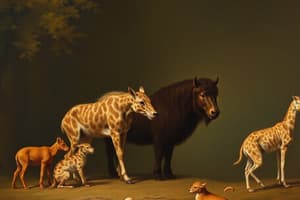Podcast
Questions and Answers
What is one advantage of breathing air compared to breathing water?
What is one advantage of breathing air compared to breathing water?
- Oxygen is liquid at atmospheric pressure.
- The partial pressure of O₂ is higher in air. (correct)
- Less water loss occurs in the respiratory process.
- CO₂ diffuses more easily into air.
Which process allows tardigrades to survive extreme dehydration?
Which process allows tardigrades to survive extreme dehydration?
- Cryptobiosis. (correct)
- Parthenogenesis.
- Metabolism enhancement.
- Aestivation.
How do terrestrial tardigrades primarily reproduce in stressed environments?
How do terrestrial tardigrades primarily reproduce in stressed environments?
- Via sexual reproduction. (correct)
- Through budding.
- By forming spores.
- Through binary fission.
What is the role of spiracles in the tracheal system of certain organisms?
What is the role of spiracles in the tracheal system of certain organisms?
What is the purpose of a cocoon for desert-dwelling frogs during aestivation?
What is the purpose of a cocoon for desert-dwelling frogs during aestivation?
What adaptation helps insects to manage gas exchange effectively?
What adaptation helps insects to manage gas exchange effectively?
Which characteristic is NOT associated with desiccation tolerance?
Which characteristic is NOT associated with desiccation tolerance?
What is a disadvantage of air-based respiration compared to water-based respiration?
What is a disadvantage of air-based respiration compared to water-based respiration?
What adaptation do terrestrial animals primarily develop to reduce water loss?
What adaptation do terrestrial animals primarily develop to reduce water loss?
Which nitrogenous waste product is excreted by reptiles, birds, and insects for water conservation?
Which nitrogenous waste product is excreted by reptiles, birds, and insects for water conservation?
How do mammals enhance water conservation during excretion?
How do mammals enhance water conservation during excretion?
What is the main factor affecting locomotion for terrestrial animals compared to aquatic environments?
What is the main factor affecting locomotion for terrestrial animals compared to aquatic environments?
What role does metabolic water play for kangaroo rats in desert environments?
What role does metabolic water play for kangaroo rats in desert environments?
Which unique feature do velvet worms possess among terrestrial animals?
Which unique feature do velvet worms possess among terrestrial animals?
Why do terrestrial insects face challenges with water loss?
Why do terrestrial insects face challenges with water loss?
What mechanism do terrestrial animals use for gas exchange to avoid desiccation?
What mechanism do terrestrial animals use for gas exchange to avoid desiccation?
Which of the following is a characteristic challenge for terrestrial animals?
Which of the following is a characteristic challenge for terrestrial animals?
What primarily limits water availability for terrestrial animals?
What primarily limits water availability for terrestrial animals?
What adaptation helps protect terrestrial embryos from desiccation?
What adaptation helps protect terrestrial embryos from desiccation?
Which strategy is primarily used by ectotherms to regulate their body temperature?
Which strategy is primarily used by ectotherms to regulate their body temperature?
What type of egg do amphibians typically lay for reproduction in water?
What type of egg do amphibians typically lay for reproduction in water?
Which of the following is NOT a constraint on the sensory systems of terrestrial animals?
Which of the following is NOT a constraint on the sensory systems of terrestrial animals?
What is the main function of the extraembryonic membranes in amniotic eggs?
What is the main function of the extraembryonic membranes in amniotic eggs?
Why do terrestrial animals expend energy on thermoregulation?
Why do terrestrial animals expend energy on thermoregulation?
What mechanism involves direct heat transfer by contact?
What mechanism involves direct heat transfer by contact?
Which of the following best describes endotherms?
Which of the following best describes endotherms?
What is the primary mechanism of heat conservation in cold-climate terrestrial endotherms?
What is the primary mechanism of heat conservation in cold-climate terrestrial endotherms?
What happens to the body temperature set point during torpor?
What happens to the body temperature set point during torpor?
Which of the following accurately describes freeze tolerance in terrestrial ectotherms?
Which of the following accurately describes freeze tolerance in terrestrial ectotherms?
What is a key characteristic of allometric growth in animals?
What is a key characteristic of allometric growth in animals?
Which group of insects is noted as heterothermic endotherms?
Which group of insects is noted as heterothermic endotherms?
How does the volume of a terrestrial organism relate to its mass as size increases?
How does the volume of a terrestrial organism relate to its mass as size increases?
What is the primary energy-consuming process that aids in cooling an organism?
What is the primary energy-consuming process that aids in cooling an organism?
Which phenomenon is associated with trends in increasing or decreasing body size in a lineage?
Which phenomenon is associated with trends in increasing or decreasing body size in a lineage?
What is the primary reason limbs must grow allometrically in larger specimens?
What is the primary reason limbs must grow allometrically in larger specimens?
Which of the following is a function of the skeletal system?
Which of the following is a function of the skeletal system?
How does the aquatic endoskeleton differ from the terrestrial endoskeleton?
How does the aquatic endoskeleton differ from the terrestrial endoskeleton?
What is the primary composition of an arthropod exoskeleton?
What is the primary composition of an arthropod exoskeleton?
Which challenge is associated with living in aquatic environments?
Which challenge is associated with living in aquatic environments?
What characterizes a hydrostatic skeleton?
What characterizes a hydrostatic skeleton?
How does the skeletal structure of terrestrial animals aid muscle attachment?
How does the skeletal structure of terrestrial animals aid muscle attachment?
What minimizes the risk of desiccation for aquatic animals compared to terrestrial animals?
What minimizes the risk of desiccation for aquatic animals compared to terrestrial animals?
Flashcards
Terrestrial Animals Origin
Terrestrial Animals Origin
Land-dwelling animals evolved from aquatic ancestors.
Desiccation Avoidance
Desiccation Avoidance
Strategies to prevent water loss, such as waterproof skin and internal organs, to live on land.
Nitrogenous Waste Problem
Nitrogenous Waste Problem
Ammonia, a toxic byproduct of metabolism, needs to be eliminated efficiently without losing vital water.
Uric Acid Excretion
Uric Acid Excretion
Signup and view all the flashcards
Urea Excretion
Urea Excretion
Signup and view all the flashcards
Loop of Henle
Loop of Henle
Signup and view all the flashcards
Metabolic Water
Metabolic Water
Signup and view all the flashcards
Insect Water Loss
Insect Water Loss
Signup and view all the flashcards
Terrestrial Environment Demands
Terrestrial Environment Demands
Signup and view all the flashcards
Cuticle in Insects
Cuticle in Insects
Signup and view all the flashcards
Desiccation Tolerance
Desiccation Tolerance
Signup and view all the flashcards
Cryptobiosis
Cryptobiosis
Signup and view all the flashcards
Anhydrobiosis
Anhydrobiosis
Signup and view all the flashcards
Tracheal System
Tracheal System
Signup and view all the flashcards
Ventilation
Ventilation
Signup and view all the flashcards
Gas Exchange with Air
Gas Exchange with Air
Signup and view all the flashcards
Vertebrate Lungs
Vertebrate Lungs
Signup and view all the flashcards
Amniotic egg
Amniotic egg
Signup and view all the flashcards
Internal fertilization
Internal fertilization
Signup and view all the flashcards
Thermoregulation
Thermoregulation
Signup and view all the flashcards
Ectothermy
Ectothermy
Signup and view all the flashcards
Endothermy
Endothermy
Signup and view all the flashcards
Conduction
Conduction
Signup and view all the flashcards
Homeothermy
Homeothermy
Signup and view all the flashcards
Uricotely
Uricotely
Signup and view all the flashcards
Exoskeleton
Exoskeleton
Signup and view all the flashcards
Endoskeleton
Endoskeleton
Signup and view all the flashcards
Bone Composition
Bone Composition
Signup and view all the flashcards
Hydrostatic Skeleton
Hydrostatic Skeleton
Signup and view all the flashcards
Aquatic Adaptations
Aquatic Adaptations
Signup and view all the flashcards
Skeletal Function
Skeletal Function
Signup and view all the flashcards
Water Density
Water Density
Signup and view all the flashcards
Allometric Growth
Allometric Growth
Signup and view all the flashcards
Evaporation
Evaporation
Signup and view all the flashcards
Countercurrent heat exchange
Countercurrent heat exchange
Signup and view all the flashcards
Torpor
Torpor
Signup and view all the flashcards
Hibernation
Hibernation
Signup and view all the flashcards
Allometry
Allometry
Signup and view all the flashcards
Freeze avoidance
Freeze avoidance
Signup and view all the flashcards
Freeze tolerance
Freeze tolerance
Signup and view all the flashcards
Study Notes
Terrestrial Animals
- Animals originated in the oceans
- Terrestrial animals are descended from ancestors that left the aquatic environment
- Earliest recorded terrestrial animal is a myriapod, ~428 million years old
- First transition to land must have happened earlier
- Relatively few animal taxa transitioned to land
- Examples include gastropods, arthropods (insects, arachnids, myriapods, crustaceans), nematodes, annelids, amniote vertebrates, etc.
- Terrestrial environments offered many evolutionary opportunities
Conditions on Land
- Terrestrial environments pose different demands than aquatic environments
- Key factors affecting terrestrial animals include:
- Gravity (posture and locomotion)
- Air (obtaining oxygen, less dense than water)
- Locomotion and sensory modes, and thermal properties
- Water (limiting resource)
- Sunlight (exposure to UV)
Life on Land
- Some requirements for terrestrial animals include:
- Desiccation avoidance (mechanisms to reduce water loss, replace lost water, tolerance mechanisms like aestivation)
- Excretion with limited water loss
- Gas exchange with air (internalized gas exchange organs, lungs, book lungs, tracheal systems)
Desiccation and The Environment (Terrestrial Animals)
- Terrestrial animals are constrained by water availability
- This affects anatomy, behavior, and physiology
- Constant water loss through evaporation
- Affects respiratory membranes
Rotifer Life Cycle
- Unstressed environment (moist): Asexual reproduction (parthenogenesis)
- Stressed environment (dry): Sexual reproduction (genetic variability)
Aestivation
- Desert-dwelling spadefoot toads spend most of their adult lives buried deeply, metabolism depressed
- Some desert-dwelling frogs secrete a cocoon while aestivating, with only nostrils open
More Requirements for a Terrestrial Life
- Desiccation avoidance (mechanisms to reduce water loss and replace lost water)
- Desiccation tolerance (aestivation and life cycles)
- Excretion with limited water loss (internal bulk flow of fluids and gasses)
- Gas exchange with air (internalized gas exchange organs like lungs, book lungs, tracheal systems)
Gas Exchange with Air
- CO2 diffuses into air less easily than water
Heat Exchange with the Environment
- Conduction: Air conducts heat poorly, water well; gill-breathing aquatic organisms tend to be isothermic with the water
- Radiation: Transfer of heat as long-wave light (e.g., basking in the sun is effective heating)
- Convection: Transfer of heat by a moving medium (air or water)
- Evaporation: Energy used in the transformation of liquid to gas, effectively removing heat
Countercurrent Heat Exchange
- Cold-climate terrestrial endotherms conserve heat through countercurrent heat exchange
- Warm blood in efferent vessels heats cool blood in afferent vessels
Torpor and Hibernation
- Torpor: reduces energy demands in small endotherms during low/high temperature periods
- Hibernation: A seasonal version of torpor
Endothermy in Insects
- Bees and some other flying insects are heterothermic endotherms
Freeze Tolerance and Avoidance
- Freeze avoidance: Some ectotherms can supercool their extracellular fluid (ECF) below 0°C
- Freeze tolerance: Some terrestrial ectotherms allow the bulk of their ECF to freeze for extended periods
Support Body Weight
- Terrestrial animals' volume (mass) is a function of (linear dimension)³
- Cross-sectional area of the limb (support and strength) is a function of (linear dimension)²
- As animals get larger, body mass increases faster than the cross-sectional area of the limbs, supporting limbs need to get proportionally bigger
Allometry
- Allometry describes how different parts of the body grow at different rates as an animal grows larger
Allometric Relationships
- Real-world limbs of larger specimens may not have sufficient thickness for efficient locomotion
- Limbs must grow allometrically to support increasing body weight with size
Studying That Suits You
Use AI to generate personalized quizzes and flashcards to suit your learning preferences.
Related Documents
Description
Explore the fascinating world of terrestrial animals and their evolutionary journey from aquatic environments. This quiz examines the unique challenges they face on land, including gravity, oxygen acquisition, and water availability. Test your knowledge about the adaptations that allow these animals to thrive in terrestrial habitats.




